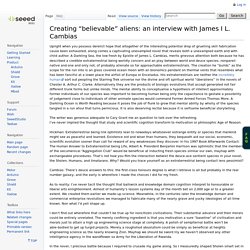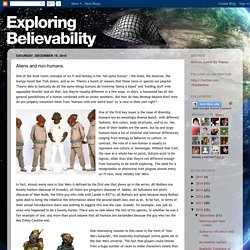

‘Star Wars’ 3D Hologram Technology Has Finally Arrived. BLEEN brings futuristic projection tech to the consumer market Ever since Princess Leia first digitally appeared before Luke Skywalker in 1977’s Star Wars Episode IV, hologram technology has been at the foreground of science-fiction plotlines and special effects.

Though holographic projection technology has arrived in limited form as an entertainment novelty (think Coachella’s Tupac hologram), it has not yet entered the everyday consumer market. Or so you may believe, until you meet the BLEEN Projection System. Bleen is a projection device that uses large-scale 3D reconstruction to create a moving holographic image. Projected images are over eight feet in height and do not require any screens, lenses, or glasses for viewing. Bleen technology relies on fast-pulsed laser beams and optical focusing systems to coordinate light color, intensity, and distribution. Elegant woman in a room full of fashion accessories Bleen systems are expected to ship in late 2015. The Life-Sized Interactive Hologram Isn't Sci-Fi Anymore. Popular Mechanics recently picked apart the "futuristic" society depicted in Pulitzer-winner Adam Johnson's his new sci-fi short story, Nirvana.

Most of Johnson's supposedly sci-fi predictions—driverless cars, spy drones—are already more science than fiction. Except for one, it claimed: "The only piece of tech that actually seems beyond our capabilities is a life-size, interactive talking hologram. " Not so fast. The life-size talking hologram promised in the fantasy films of yore is, too, creeping toward reality. The holographic technology startup Provision 3D Media has successfully produced 3D floating virtual images up to 52 inches large, and now it's setting out to develop a working life-sized hologram. The startup is trying to raise $950,000 on Kickstarter to develop and test the prototype. Sci-Fi to Sci-Fact: Star Trek Food Replicator – Slice of SciFi.
Making believable aliens without the guy in a rubber suit effect [Archive] - RPGnet Forums. This is a little off the subject of RPGs, as it relates directly to movies.
![Making believable aliens without the guy in a rubber suit effect [Archive] - RPGnet Forums](http://cdn.pearltrees.com/s/pic/th/believable-without-archive-101678839)
I recently watched my super-dooper anniversary edition of Aliens, which contains an interview with James Cameron. During this interview, he talks about the 'rubber suit syndrome' common in sci-fi movies. According to Cameron, the thing that most easily tips a viewer off that a creature is simply a man in a rubber suit is not so much the appearance of the creature being portrayed, but the way it moves. Humans have a very specific way of moving, and most humans are keyed into that. Creating Fantasy Creatures and Alien Species. I read a great blog some time ago (here and here) about the use of non-human characters in fantasy and science-fiction.

It’s true that non-human creatures are a staple of these genres; and for those of us who write sci-fi and fantasy, creating new creatures is part of the fun of world-building. I’m not going to lay out rules for creating magical creatures or alien life-forms. Are you writing believable non-human characters? Adapting Earth Animals into Alien Lifeforms. Holly Lisle's Vision By S.L.

Viehl © 2002, S.L. Viehl Here’s a bit of movie trivia you probably don’t know: Charles Bailey III, the Chief Model Maker and the man who helped created Stephen Spielberg’s E.T. the Extra-Terrestrial (1981), told a reporter that he inverted a domestic cat’s head when he made the preliminary sketches of the much-beloved alien’s face. Writing science fiction and fantasy novels usually means populating your story with other-than-human life forms. Science fiction authors, on the other hand, produce a lot of very strange critters. From science fiction to reality the future of communication is with Holograms. Imagine that you’re out to dinner with your best friend.

The sun is out, you look glorious, and your friend asks you, “What makes a good relationship?”. Now there is no right answer here, but the answer most “experts” (we use the term experts very loosely) would be communication. What communication is, and how we do it however, has changed rapidly with technology. For example society has moved from sending love letters to each other to tweeting #luv xxx B&C. Creating Believable Aliens. The Hubble telescope, the Voyager probe, DNA and the study of genetics have all changed the way we view our world.

Computers have given us the ability to research at the speed of light and the average person has access to greater knowledge than has ever been possible in the history of mankind. These things are also reflected in the stories we write. No longer can a science fiction writer create a goo-dripping alien just because a story line requires an adversary from another planet to drop in on our unsuspecting world.
The average reader is not going to buy into the B-rate movies of old. It takes more than an actor in a rubber mask for them to suspend their disbelief and enjoy a story or novel. Creating “believable” aliens: an interview with James I L. Cambias. Upright when you possess derelict hope that altogether of the interesting potential drop of gruelling skill fabrication cause been exhausted, along comes a captivating unexampled novel that reveals both a unexampled earth and with child author.

A Darkling Sea, the low fresh by Epistle of James L. Cambias, merits grievous attention both because he has described a credible extraterrestrial being worldly concern and an play between world and deuce species, nonpareil native and one and only not, of probably alienate so far approachable extraterrestrials. The creation he “builds” as the scope for the run into is an glass covered ocean moon with an bionomics pendant on thermal vents that resembles what has been fanciful at a lower place the airfoil of Europa or Enceladus. His extraterrestrials are neither the incredibly human sort out peopling the Starring Trek universe nor the divine and oft spiritual world “überaliens” in the novels of Chester A. Main/Teleporters and Transporters. Main/Hologram. Advances in Holographic Technology Could Have Far-Reaching Implications. By Michio Kaku For decades, holograms have been seen largely on the screen, in sci-fi movies and TV shows like "Star Wars" and "Star Trek.

" The famed holodeck on "Star Trek" was used on a variety of the Federation star ships and was mostly seen when someone had to visit the sick bay as part of the "Emergency Medical Holographic program" (EMH). A 3-dimensional transparent image of someone would suddenly appear—but it was also something that you could interact with and ask questions. Exploring Believability: Aliens and non-humans. One of the most iconic concepts of sci-fi and fantasy is the "not quite human" - the elves, the dwarves, the bumpy-faced Star Trek aliens, and so on.

There's a bunch of reasons that these races or species are popular. They're able to basically do all the same things humans do involving "being a biped" and "holding stuff with opposable thumbs" and all that, but they're visually different in a few ways. Three Types of Teleportation. I’m sure most Mysterious Universe followers know all about Charles Fort, who was one of the great pioneers in the systematic study of anomalous phenomena. I’m equally certain that the average person in the street has never heard of him. But even so, they’re probably familiar with one of the words that he coined: Teleportation. It’s now so much a part of the English language that it’s just as likely to be dropped into conversation by a quantum physicist or a science fiction fan as by a Fortean researcher. The frustrating thing is that those three groups of people – Forteans, sci-fi fans and physicists – all tend to use the word in subtly different ways.
Fort himself first used the word “teleportation” in his book Lo! To Fort, “teleportation” was a psychic phenomenon analogous to telepathy or telekinesis. “There may be teleportation, and maybe for ages the secret of it has been known by esoteric ones,” Fort says at one point in Lo!. Human Teleportation. Sadly, the transporters of "Star Trek" and the telepods of "The Fly" are not only a far-future possibility, but also perhaps a physical impossibility. After all, a transporter that enables a person to travel instantaneously to another location might also require that person's information to travel at the speed of light -- and that's a big no-no according to Einstein's theory of special relativity. Also, for a person to teleport, the teleporter's computer would have to pinpoint and analyze all of the 1028 atoms that make up the human body.
How Time Travel Works " From millennium-skipping Victorians to phone booth-hopping teenagers, the term time travel often summons our most fantastic visions of what it means to move through the fourth dimension. But of course you don't need a time machine or a fancy wormhole to jaunt through the years. As you've probably noticed, we're all constantly engaged in the act of time travel. At its most basic level, time is the rate of change in the universe -- and like it or not, we are constantly undergoing change. We age, the planets move around the sun, and things fall apart. Why Don't We Have Teleportation? Theoretical physicist and unstoppable optimist Michio Kaku thinks humanity will achieve a version of teleportation in the real world.
He predicts the transport of a molecule in the next 10 years, soon followed by DNA. But making it to Captain Kirk will take "centuries of work," he says. For now, teleportation is stuck at the quantum level. 10 Futuristic Technologies That Will Never Exist. I would very much like to read an article from you about the 'continuity of consciousness' problem. It is the only thing on your list that I can't imagine a way around. Well, i can, but i dip into gnostic spirituality for the theoretical bits, and i would like to see a more scientific based approach.
The transition of neurons you mention in other replies sounds like a good start to me. But that raises concerns about an idea i came across in Mass Effect regarding AI's and their blue boxes. Sure it's just science fiction, but i wonder how much truth there is to the idea? How to Create a Scientifically Plausible Alien Life Form. All the Evidence that Time Travel is Happening All Around Us. It's Made Of SCIENCE: Aliens. Researchers Advance 'Quantum Teleportation' Yes, Time Travel Is Possible; Here's How.
The Replicator Is Still Sci-Fi, But Here's A Start. Time Travel: Theories, Paradoxes & Possibilities. Time travel may be theoretically possible, but it is beyond our current technological capabilities.Credit: argus | Shutterstock Time travel — moving between different points in time — has been a popular topic for science fiction for decades. Franchises ranging from "Doctor Who" to "Star Trek" to "Back to the Future" have seen humans get in a vehicle of some sort and arrive in the past or future, ready to take on new adventures. Teleportation, Materialization and Invisibility. Why Star Trek Transporters and Replicators Remain Science Fiction. The Holographic Future: From Science Fiction to Reality. Writepop - Science fiction stories, humor, and writing about writing.
Ne issue many, if not most, science fiction writers will face is creating convincing aliens. Scientists Explain Why Time Travel Is Possible. In H.G. Teleportation. Teleportation, or Teletransportation, is the theoretical transfer of matter or energy from one point to another without traversing the physical space between them. It is a common subject of science fiction literature, film, and television. Holography in fiction. Terraforming. Creating “believable” aliens: an interview with James L. Cambias. SoYouWantTo/Create Believable Aliens. 13 Aspects About Aliens You Shouldn't Ignore — Veronica Sicoe. The Only Sci-Fi Explanation of Hominid Aliens that Makes Scientific Sense : Science Not Fiction. Sci Fi Factor - Creating Believable Aliens. Sci Fi Factor - Creating Aliens. Space Truckin’ – the Nostromo. Teleportation Like That Seen On 'Star Trek' Unlikely In Real World, Physicists Say. MMolvray, exobiology, evolution, and fiction. What's the most believable alien in science fiction?
Basic Tips To Create More Believable Sci-Fi & Fantasy Religions & Belief Systems. Fantasy and Science Fiction Writing » How to Build a Believable Alien. The 10 Most (And Least) Accurate Sci-Fi Movies. Alien languages! Alien Language Creator (and translator) on Scratch. Creating the next great alien language... why? How to Create an Alien Language. How to write the next great alien language.
Want to Invent an Alien Language? Constructed language. Building An Alien Society From The Ground Up. Creating a believable alien culture. Star Trek and the Image of God. So You Want To/Design An Alien Mind. Worldbuilding - Tips to Create Better & More Believable Fantasy & Science Fiction Species. Creating Believable Fictional Worlds. The Big Question Writing Course.